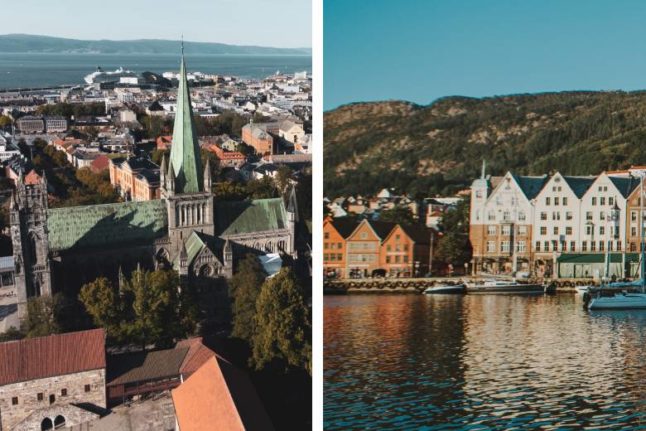It wouldn’t be fair to start this comparison without first saying a few words about the numerous similarities between Bergen and Trondheim.
By Norwegian standards, both are major cities – Bergen has a population of over 285,000 residents, while more than 205,000 call Trondheim their home. That makes them the second and third-largest cities in the country, respectively.
Both can be considered fairly international cities too. The number of immigrants and children born in Norway to foreign parents make up 16 percent of the population in Trondheim and 18 percent residents in Bergen.
Furthermore, both cities are magnets for outdoors enthusiasts, as they are surrounded by forests and mountains. They’re also well-known for their lively student culture, which stems from their vibrant international student communities.
However, if you’re reading this article, you’re likely to be more interested in the differences between Bergen and Trondheim.
Location and climate
Trondheim is situated in central Norway, while Bergen is located on the west coast. Furthermore, the city of Trondheim is situated further north. Northward car drive to Trondheim from Bergen takes a whopping 11 hours.
The winters in Trondheim are characterised by their extended periods of darkness and low temperatures that can often fall below the freezing point, which may be challenging for some people.
Due to its location and proximity to the ocean, Bergen has a milder and more temperate climate. In contrast, Trondheim usually has colder, more continental weather and more volatile temperature swings.
READ MORE: Six things foreigners should expect if they live in Bergen
Don’t let Bergen’s milder temperatures fool you – while the weather in western Norway is not as harsh, Bergen is known as the “rain capital of Norway,” and it gets more than 230 rainy days each year (Trondheim, on the other hand, has around 150 days with precipitation a year).
While Bergen is also known as the “gateway to the fjords,” Trondheim’s more central location makes it a good hub for travel to other parts of the country, including Oslo and the north of Norway.
The dialects: Bergensk and Trøndersk
Bergen and Trondheim have two distinct and different dialects. Bergen has a distinct dialect called “Bergensk,” while Trondheim has its own dialect called “Trøndersk.” Both are characterised by different and distinct pronunciations.
The Bergen dialect is more similar to Nynorsk (one of the two written standards of the Norwegian language, along with Bokmål) in pronunciation.
As online language school Skapago points out on its website, the dialect stands out due to the pronunciation of “r” and the kj-sound.
As any grammar guide will tell you, in the Bergensk dialect, the “r” is pronounced as a uvular “r,” not with the rolling pronunciation you’ll find in eastern and northern Norway. You can find out more about the Bergen dialect in The Local’s beginner’s guide to Bergensk, here.
On the other hand, Trondheim has its own unique dialect (to be more precise, a group of sub-dialects), called Trøndersk, characterised by a distinct pronunciation and a unique vocabulary.
This dialect stands out due to its vowels, tonality, and palatalisation – you can find out more about Trøndersk in this article in the Great Norwegian Encyclopedia (in Norwegian).
Both rank among the hardest for novice and intermediate Norwegian speakers to understand.
Industries and job opportunities
Bergen has a strong economy, with a notable focus on tourism, hospitality, shipping, marine, oil, and seafood sectors. Each year, the high number of job opportunities in these sectors attracts many international citizens looking for work.
For its part, Trondheim is known for high-tech industries (and the Norwegian University of Science and Technology – NTNU), including biotechnology and renewable energy, which provide career opportunities in these fields.
However, as Trondheim is also increasingly popular with tourists, the number of job openings in tourism has increased in recent years.
Cost of living
Generally speaking, the cost of living in Trondheim is lower compared to Bergen, primarily due to lower accommodation costs and lower prices for some goods and services.
In any case, Bergen is considered a more tourist-oriented city overall, which also has a certain effect on prices – especially when it comes to restaurants and accommodation options.
So, while housing costs vary depending on location, if you’re looking to rent, you’ll likely find that housing is more affordable in Trondheim compared to Bergen.
According to the Utleiemegleren rental agency’s figures for January of 2023, renting a 2-bedroom in Trondheim costs 12,003 kroner on average. On the other hand, the average price for a 2-room apartment in Bergen was 13,101 kroner in the same month.
The rental price difference might not seem that big at first glance, but over time, it can add up to significant amounts. Additionally, energy prices are typically cheaper in central Norway than elsewhere.
The Northern Lights
Seeing the Northern Lights in western Norway is an uncommon occurrence. Due to its location and the growing light pollution, most years, you’ll be lucky if you catch a glimpse of the Aurora Borealis in Bergen.
So, while it is possible to see the Northern Lights from Bergen, their appearance is sporadic, and they are definitely not a common sight – that’s why many people who live in Bergen make the trip north when they want to substantially increase their odds of seeing the magical lights flicker in the night sky.
The situation is entirely different in Trondheim, which is situated in northern Norway and broadly considered a prime location for viewing the Northern Lights during the winter months.
Just know that there are never any guarantees that you’ll see the Northern Lights – even in a place with dark nights in the north of Norway, such as Trondheim.
However, if you’re patient enough, if you plan your visit between September and March when the darkness is complete, and if you manage to find a great spot on any of the mountains in the vicinity of Trondheim – such as Forbordsfjellet or Gråkallen – you’ll increase your odds of seeing this majestic phenomenon.



 Please whitelist us to continue reading.
Please whitelist us to continue reading.
Member comments